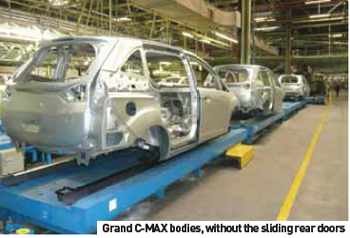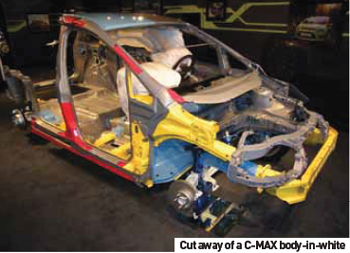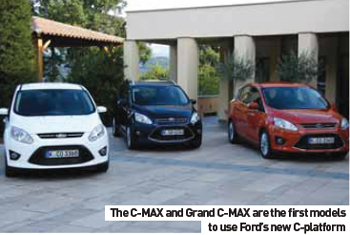
The Ford C-MAX and Grand C-MAX are the first vehicles to be based on the company’s new C-platform. AMS examines the vehicles’ new features and how these changes have influenced production at the plant in Valencia, Spain
The first-generation Ford C-MAX was based on a modified Focus platform. With a longer wheelbase and raised roof, the MPV was designed to compete with models such as the Opel/Vauxhall Zafira and Renault Megane.
While the Focus-derived running gear gave the car class-leading handling, it lacked the surprise-and-delight features popular in this segment, and perhaps more importantly, a seven-seat option.
The second-generation C-MAX is again based on same C-platform that will underpin the new Focus, but in addition to the standard model, the range now includes the seven-seat Grand C-MAX. Although the two cars are identical back to the B-pillar, the larger version features an extended wheelbase (140mm), higher roof (58mm), optional third-row seating and twin rear sliding doors – a first for a Ford passenger car – to improve ease-of-entry to the rear passenger space. The stiffer bodyshell features an increased percentage of high-strength steels, with special attention paid to the attachment points between chassis and running gear to help further improve driving dynamics.
Rainer Geschwentner has been program manager in charge of product development for the new C-MAX for the past for three and a half years. “I have been involved with developing the car’s technical aspects from Day One. The process started with vehicle design, layout, and the features to be introduced into the new vehicle. We also covered package investigation, set targets with regards to vehicle attributes, and how the car behaves on the road, steering feel, driving control, NVH.”
Each of the updates was engineered into the new model and signed off using Ford’s new digital pre-assembly process, as Geschwentner explains. “Feasibility studies were carried out in close co-operation with manufacturing specialists in order to validate the design changes. This was done at a much earlier stage than ever before and it worked very well. When we put together the first prototypes in 2009, it was unusual as we didn’t have one instance where we said this was a complete ‘no go’ in terms of building the car.”
He further points out that beyond stamping and welding of the exterior panels, this process included a review of the Valencia assembly line. “At the same time we were analysing the interior and exterior design of the car, we were also looking at how to improve assembly line ergonomics. In a virtual factory, we worked closely with the manufacturing team to improve processes, much more so than with previous projects.”
The underlying driver for these changes was the size of the C-MAX; it is the largest model to enter production at Valencia. To accommodate the new, larger cars, Geschwentner says that a completely new chassis conveyor system had to be installed. “We had a fixed conveyor system for the previous model. In order to compensate for the height of the new C-MAX, we installed an adjustable, programmable conveyor system from Rofa, which improves access and allows build operations to be completed more efficiently.”
 According to Rainer Geschwentner, Valencia is the most flexible European plant in the Ford portfolio. In addition to the new C-MAX and Grand C-MAX, the plant also produces the B-platform Fiesta and previous-generation Focus on a single assembly line. He explains that the thirdrow seating option and sliding doors of the Grand C-MAX have placed a very high demand on the plant’s flexible set up, as application of the additional features is not done in dedicated stations, but are incorporated into the standard build process.
According to Rainer Geschwentner, Valencia is the most flexible European plant in the Ford portfolio. In addition to the new C-MAX and Grand C-MAX, the plant also produces the B-platform Fiesta and previous-generation Focus on a single assembly line. He explains that the thirdrow seating option and sliding doors of the Grand C-MAX have placed a very high demand on the plant’s flexible set up, as application of the additional features is not done in dedicated stations, but are incorporated into the standard build process.
“Each body leaving the BIW area is fitted with an RFID tag. At that point, you can’t take the car out of sequence, it would severely affect lineside part delivery. Keeping in mind the volumes we are going to produce, you would need an incredibly flexible system to support removing cars from the line to complete individual build processes.”
Complexities surrounding production of the sliding doors can be traced back to the weld shop. Unlike a standard, hinged door, which is welded in the bodyshop in preparation for e-coat and paint, the mechanics of the sliding doors cannot be assembled before painting. The solution is to use a specially-designed slave tool which positions and holds the doors against the body as it travels through the paint application process. Upon completion, the reusable attachment tool is dismounted and the door mechanisms are added.
 Like their hinged counterparts, the sliding doors are removed for sub-assembly kitting at the start of the trim line, but require a specially-designed handler to help with final application to the body, as the doors must be lined up with top and body-side hangers for correct mounting.
Like their hinged counterparts, the sliding doors are removed for sub-assembly kitting at the start of the trim line, but require a specially-designed handler to help with final application to the body, as the doors must be lined up with top and body-side hangers for correct mounting.
Manually-operated, the doors also have a special mechanism that lock them into place when open.
As mentioned, this is the first time Ford has used sliding doors on a passenger model. Geschwentner: “The Transit and Transit Connect have sliding doors, but not passenger cars. The Galaxy (full-size people carrier) has never had this feature; it has been quite a challenge. Compared to LCVs, there are completely different requirements in terms of finish, and gap and flush. The digital pre-assembly process and feasibility investigations were critical in achieving the successful application of this feature.”
In total, high-strength steel comprises 53% of the bodyshell of the new C-MAX, compared to 45% in the previous model. Ford says this has resulted in a much stronger passenger safety cell, while also helping to improve handling dynamics.
“The new chassis is considerably stronger,” says Rainer Geschwentner. “If you consider hot-formed rolled steel, this made up 2% of the previous model. In the new C-MAX, this has been increased to 10% of the total bodyshell.” He adds that press tooling had to be upgraded to handle both the increased usage of high-strength product and the overall increase in pressed parts due to the addition of the sliding side doors.
A sheet metal tower brace, formed using high-strength steel and integrated into the bulkhead, has been added to the new C-MAX in order to stiffen the chassis and improve vehicle handling. Connecting the two suspension towers, the part mimics a technique used in various high-performance cars, but Geschwentner says that there are key differences.
“On sports cars these are extra-mounted parts; very strong bushes that are bolted onto the towers. For the C-MAX, the part is integrated into the sheet metal. It’s welded to the car in the bodyshop instead of being applied in final assembly.”
As with the other models manufactured at Valencia, stampings for the C-MAX are produced in the facility’s on-site press shop; a limited number of underbody parts are delivered from Ford’s Saarlouis plant. Ford Cologne provided the tooling For the Class 1A exterior panels, development of which took 16 months. A range of external suppliers have developed tooling for production of smaller internal parts.
Steel is provided by ArcelorMittal and ThyssenKrupp. High-strength and dual-phase steels are used in such areas as the front crash structure, which helps manage impact forces and maintain crush structure, although the C-MAX and Grand C-MAX use different gauges to compensate for vehicle weight. Ultra-high strength steels are used for the Aand B-pillars, rocker panels and door reinforcement beams in order to create a more rigid passenger cell.
Welding at Valencia is split between two separate bodyshop lines, each producing two models: Bodyshop 1 delivers the Fiesta and Grand C-MAX, Bodyshop 2 the Focus and C-MAX. While the majority of panel joins are completed using standard spot welds, middle frequency guns fitted with automatic weld parameter controls are used to join boron steels.
Asked if Ford has carried over any elements of the latest Fiesta for the new C-MAX model, such as the centre console design that loosely mimics a mobile phone, Rainer Geschwentner, Programme Manager at Ford’s Valencia plant, outlines how the company tailors vehicle design to suit different customer segments. “The first step in developing a new vehicle is defining the target customer.
The target customer for Fiesta is not the same as for the C-MAX. (The car) has completely different usage requirements and must fulfil a different set of customer needs. There maybe crossovers, as in the case of the control panel, where both sets of customers like the same elements, but there might be completely different conclusions for other elements.
So we define the target customer and then look at what we have in our range of products, what we can implement in the new vehicle. Doing this, we also find that certain technologies are not available, so we have to develop them. From this, we develop a package which is the best fit for the customer.
The new C-MAX models offer a wide range of optional equipment, including a premium Sony sound system and rear climate control. While adding complexity to the build process, Geschwentner says application of these items has been built into standard takts across vehicle assembly.
“The addition of optional equipment is addressed within existing stations. In the case of the sound system, we get the assembled IP delivered lineside just-in-sequence via a conveyor belt and we also get the centre console (which includes the sound system) and the two match. With regards to elements such as rear climate control, it doesn’t matter if they are included or not, installing the different IP units takes the same time. The plant is currently running on slightly reduced line speeds, but these will gradually increase as line workers become more familiar with the build processes. We won’t adjust line speed to accommodate individual versions.”
Geschwentner says the IP modules, which feature covers made from slush-moulded, soft-touch plastic, will be installed using a new, automated system. Presented to the vehicle via a robotic arm, the IP is not positioned using physical jigs, but aligned using lasers before being bolted in position. “The system was installed for ease of assembly, not to protect the soft-touch surface of the IP unit,” he adds.
A variety of parts are delivered to the Valencia plant from a purpose-built supplier park. “Our biggest supplier is JCI (Johnson Controls International), which is responsible for the IP, seats and door inserts. They deliver a considerable portion of the interior.” Headliners for the C-MAX models are delivered by Grupo Antolin, and Lear provides wiring harnesses. Seating is conveyored into the factory, while other parts are trucked to the assembly line.
A range of new parts and processes have been incorporated into production of the new C-MAX models in order to improve noise, vibration and harshness characteristics. These include the addition of an ‘insulated’ windscreen, supplied by Sekurit. “The windscreen has an acoustic laminate between the glass sheets,” says Geschwentner. While all windscreens have a laminate, he says that this is a special product that further serves as a sound-dampening device to reduce road noise.
In the bodyshop, additional insulation is added to achieve similar results. “We have significantly increased the amount of insulation added in the metal shop. The application rates for these magnetic or sprayable dampeners have been massively improved, which has allowed additional quantities (of material) to be added in the same timeframe.”
Another significant improvement over the out-going model is how openings between the engine and passenger compartments have been closed. “We have been much more rigorous than in the past, applying sealants in these areas.
While these were of course sealed, it’s a case of attention to detail, using more product in a better way and drawing attention to openings that hadn’t been taken care of in the past as they were in very remote areas of the engine bay.”
The first model to be based on Ford’s new C-platform, build processes developed for the new C-MAX in Valencia will be used as production templates for future models using the same platform. This also includes adoption of the same conveyor system installed to accommodate the increased vehicle dimensions. “It’s part of the Bill of Process, the introduction of a new global product,” says Rainer Geschwentner. “Production in all affected assembly plants will have to be aligned. This includes Saarlouis, Michigan, St. Petersburg (Russia), Chongqing, Taiwan and Thailand.” A new C-Car is also anticipated to enter production in Louisville, Kentucky, although Ford has yet to announce which model this will be.
Basing global production on a single platform clearly has its benefits, as capital expenditure is reduced through economies of scale when purchasing manufacturing equipment and parts. On the other hand, production elements are reduced to the lowest common denominator, meaning that if some plants can produce parts that others can’t, the global benchmark will be set at the plant with more limited part production capabilities.
Such is the case with the C-MAX, as Geschwentner explains: “Due to the Bill of Process, we are limited as to the maximum number of die steps. So every design change that would require five, six, or more process steps is not possible.
Had we been able to use these additional pressing steps, we could have built additional design cues into the car.”
Hybrids and application equipment
 Ford has confirmed that the five-seat C-MAX will be the company’s first European model offered with a hybrid powertrain. The range will include HEV and PHEV versions, which will be launched in 2013, joining two other pure electric vehicles, the Transit Connect Electric (2011) and Focus EV (2012), while a second hybrid model is expected to use the CD-platform, the chassis used for the current Mondeo.
Ford has confirmed that the five-seat C-MAX will be the company’s first European model offered with a hybrid powertrain. The range will include HEV and PHEV versions, which will be launched in 2013, joining two other pure electric vehicles, the Transit Connect Electric (2011) and Focus EV (2012), while a second hybrid model is expected to use the CD-platform, the chassis used for the current Mondeo.
Three separate stampings are welded together to make the floorpan of the new C-MAX. Do these parts already include the necessary adaptations to accommodate the battery packs and electric motors associated with a hybrid powertrain? “As far as I’m aware, we will not have to make substantial changes to the floor panels,” says Geschwentner.
“The volumes of the hybrid versions are not expected to be too high, so it would not be feasible from a cost perspective to have new panels produced for such a small number of cars.” He adds that brackets may have to be designed, or redesigned, in order to support the new systems.
Has the production line been altered in any way in order to support production of the hybrid models, keeping in mind that assembly workers will have to handle heavy parts with very high energy charges? “I don’t have any specifics, but if there is any potential safety risk, the plant will do whatever it takes to remove that risk.”
An example of improved work areas on the assembly line is the addition of what is called a ‘happy seat’. “Previously, workers had to lie on the floor to install fuel lines at the back of the car. The new arrangement, working in conjunction with the adjustable assembly line, allows access to the underside of the car to improve ease of installation.”
In all, a broad range of new technologies have been incorporated across the various production areas for assembly of the new C-MAX models, to benefit production line personnel and improve finished vehicle quality. There has been a substantial increase in the number of surpriseand- delight features, including a power operated tailgate, electronically-controlled child locks and a ‘capless’ refuelling system. What the out-going model lacked, the new car has in spades, which in combination with an excellent chassis, is sure to place the C-MAX high on the global sales list.






































